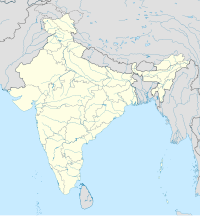This article has multiple issues. Please help improve it or discuss these issues on the talk page. (Learn how and when to remove these messages)
|
| Guruvayur Temple (Gurupawanapuri) | |
|---|---|
 Guruvayur Shri Krishna Temple | |
| Religion | |
| Affiliation | Hinduism |
| District | Thrissur |
| Deity | Guruvayurappan (Vishnu with four arms) in his form of Krishna |
| Festivals | Janmashtami, Kumbham Utsavam, Guruvayur Ekadasi |
| Governing body | Guruvayur Devaswom Board |
| Location | |
| Location | Guruvayur |
| State | Kerala |
| Country | India |
| Geographic coordinates | 10°35′40″N 76°02′20″E / 10.5945°N 76.0390°E |
| Architecture | |
| Type | Kerala Architecture |
| Creator | As per tradition, Vishwakarma (sculptor) Brihaspati and Vayu (pratishta) |
| Completed | The temple was completed around 14th century, The earliest temple records date back to the 17th century. |
| Inscriptions | Murals |
| Elevation | 12[1] m (39 ft) |
| Website | |
| www | |
Guruvayur Temple is a Hindu temple dedicated to Guruvayurappan (four-armed form of the Vishnu), located in the town of Guruvayur in Kerala, India. Administrated by the Guruvayur Devaswom Board, it is one of the most important places of worship for Hindus in Kerala and Tamil Nadu and is often referred to as Bhuloka Vaikunta (Holy Abode of Vishnu on Earth).[2] The temple is Classified one among the 108 Abhimana Kshethram of Vaishnavate tradition.
The central icon is a four-armed standing Vishnu carrying the conch Panchajanya, the discus Sudarshana, the mace Kaumodaki, and a lotus with a tulasi garland. This image represents the form of Vishnu as revealed to Krishna's parents Vasudeva and Devaki around the time of his birth. Worship proceeds according to routines laid down by Adi Shankara and later written formally in the Tantric way, the inter-religious spiritual movement that arose in medieval India, by Chennas Ravinarayanan Nambudiri (1427-1527), whose descendants are the hereditary tantris (high priests) of the Guruvayur Temple.[3]
The temple is managed by A special administrative authority under the control of the Government of Kerala. The main festivals of this temple are the 10-day festival in the Malayalam month of Kumbham starting with flag hoisting on Pooyam star,[4] Krishna Janmashtami (Birthday of Krishna) in the month of Chingam,[5] Ekadasi (11th day) in the shukla paksha (bright fortnight) in the month of Vrischikam, popularly called as the Guruvayur Ekadasi[6] and Vishu on the first day of the month of Medam, once a harvest festival.[5]
The temple's sub-deities are Ganapathi, Ayyappan, and Bhagavathi (Who is given more importance), and there are two sub-temples, one for Ganapati and the other for Nagadevathas (Snake deities nearby the temple. All non-Hindus are prohibited from entry within the Guruvayur Temple.
- ^ Guruvayur Elevation
- ^ www.guruvayurdevaswom.in https://www.guruvayurdevaswom.in/. Retrieved 25 November 2020.
{{cite web}}: Missing or empty|title=(help) - ^ "www.guruvayurdevaswom.in - Official Website Of Guruvayur Devaswom". guruvayurdevaswom.in. Retrieved 12 May 2020.
- ^ "Archived copy". Archived from the original on 25 February 2019. Retrieved 22 February 2019.
{{cite web}}: CS1 maint: archived copy as title (link) - ^ a b "Archived copy". Archived from the original on 16 February 2019. Retrieved 22 February 2019.
{{cite web}}: CS1 maint: archived copy as title (link) - ^ "Archived copy". Archived from the original on 11 February 2019. Retrieved 22 February 2019.
{{cite web}}: CS1 maint: archived copy as title (link)


